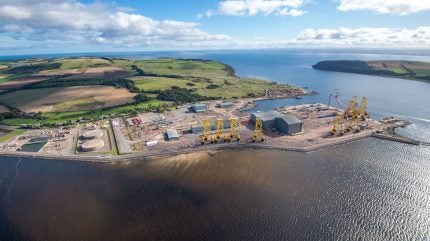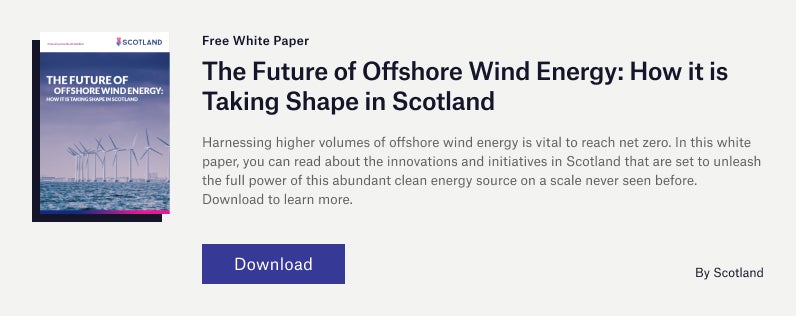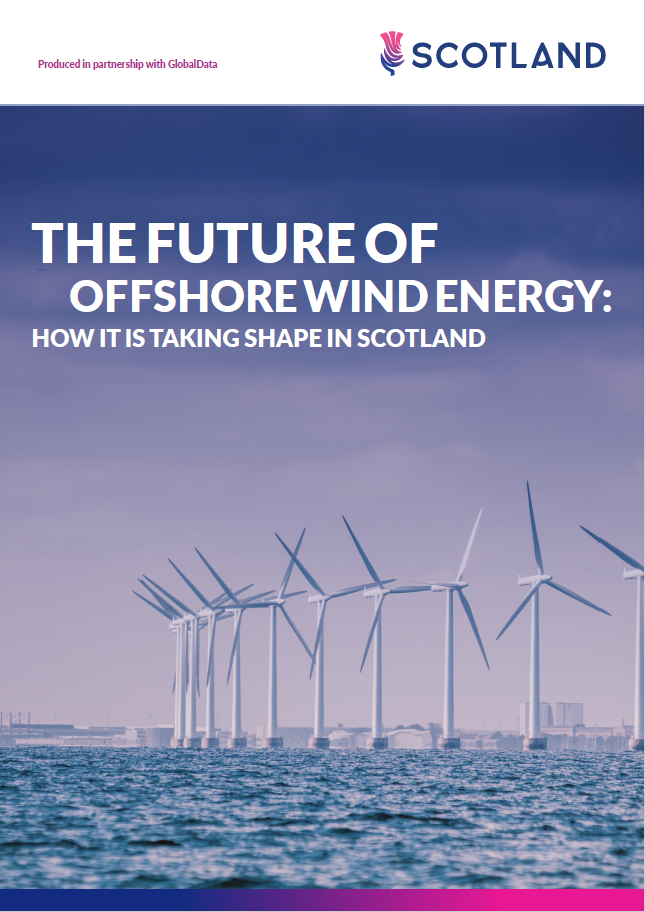
Scotland’s two green freeports are integral to accelerating the expansion of its offshore wind industry, notably for floating turbines in deeper waters.
The idea is for the UK’s 12 freeports to have specific areas of expertise and target economic areas to unlock their potential through a blend of modified regulations, tax and customs tariffs to attract major inward investment. These variations are intended to provide operating cost advantages with lower taxes on employment and property, along with custom facilitation and tariff suspension measures for certain inbound and outbound trade.

In Scotland, two proposed green freeports – Inverness and Cromarty Firth Green Freeport (ICFGF) and Forth Green Freeport (FGF) – are focused on the energy transition and decarbonisation agenda and could together create 60,000 new, high-quality jobs.
A significant advantage of Scotland’s freeports for wind energy is the close proximity of deep-water ports to the offshore wind development areas in the North Sea, combined with established industrial bases and major development land. If wind turbine components can be manufactured near a port, it avoids the potential need to transport a 100-metre blade via road or across the seas from another nation.
With the ScotWind and INTOG leasing rounds potentially adding 35GW of offshore wind generation capacity, there is a particular focus on developing a supply chain where project developers can use components manufactured in Scotland or local engineering expertise.
The terms of the leasing rounds set an obligation to source from Scotland as much as possible.
With considerable demand for related products and services, the ambition is for many of these to be available from Scotland’s green freeports. Furthermore, the recently announced extension to the investment incentive window until 2034 is anticipated to provide a further boost to the green freeports’ development potential – particularly for floating offshore wind, as the new industry will enter its commercial-scale delivery phase in the 2030s.
“The level of interest at this time is unprecedented,” Calum MacPherson, CEO of ICFGF. “The breadth of it is interesting as it’s not just big multinationals involved in offshore wind from Europe, Asia, and North America. We also have a lot of interest from the supply chain – everything from chains to boats to training to IT systems, environmental consultants to recruitment companies. It’s a broad range of businesses looking to come here.”
Green freeports: wind energy opportunities for the Highlands
ICFGF covers 520 hectares of mostly brownfield land that will be redeveloped or repurposed for green energy industrial use. Plans will grow the large engineering capability in a region already playing a leading role as a cluster of heavy engineering for offshore wind in Europe.
The partnership behind ICFGF consists of organisations such as the Port of Cromarty Firth, Global Energy Group and Haventus working alongside local and national businesses, as well as academic institutions and local government.
Existing port infrastructure is a particular advantage from two sites within the freeport area, the Port of Nigg and the Port of Cromarty Firth. Specifically, the deep-sea ports used historically for oil & gas offer many benefits for offshore wind. Water depths of 22 metres provide sufficient clearance for the heaviest vessels. One company developing new quayside infrastructure at its site at Ardersier is Haventus, on a significant area of land that can support offshore wind manufacturing.
Moving 10,000-tonne structures is a complex operation. In a busy port, such processes must be planned stringently to negotiate heavy traffic in shipping lanes.
Seaways in the ICFGF region are currently far less busy than major ports in Europe such as the Port of Rotterdam, for example, where slots must be booked in advance to get shipments in and out of the facility, with scheduling typically tight due to the sheer volume of traffic. Operating out of ICFGF close to the North Sea, vessels can travel in and out of the ports relatively easily – likely without requiring so closely planned time slots.
The ports of Nigg and Cromarty Firth also have heavy lift capabilities, with experience in the area of assembling rigs for the oil & gas industry, along with wet storage options for floating wind structures.
“You can move pretty freely in and out of the ports,” adds MacPherson. “If you add deep, sheltered water and proximity to existing fabrication facilities, you’ve got a unique mix.”
How freeports can help with regeneration
Investments are already taking shape in the region. Port of Ardersier near Inverness has attracted £300m in investment from US firm Quantum for the redevelopment of the former oil yard site to serve the offshore wind sector. In addition, the Port of Nigg is the site of a £350m investment led by Japanese firm Sumitomo to build a subsea cable factory for offshore wind turbines.
“We’ve large brownfield sites that have sat dormant for a very long time, but we’re now experiencing levels of interest not seen for decades,” says MacPherson.
ICFGF is predicted to be to major contributor to the green economy in the UK, delivering for local communities while furthering global advances in key areas of renewables such as floating wind technologies.
“For us, it’s not just about an economic development, it’s really important for us in terms of [regeneration] and trying to address some social impacts,” says MacPherson.
ICFGF is involved with reskilling programmes for oil & gas professionals and is speaking with schools in the area to increase awareness about careers in offshore wind for the next generation of developers and manufacturers. The intention is to keep talent in the region and offer an alternative to moving for opportunities elsewhere.
“We’re helping create a future energy workforce in the area,” adds MacPherson. “We’re helping to upskill, attract and retain talent in the area. We’re helping people transition from oil & gas over to renewable energy. As oil & gas slowly declines, they’ll be looking for new employment to help them transition into new careers.
Building offshore wind manufacturing hubs in Scotland
The Forth Green Freeport (FGF) is intended to deliver sustainable economic growth across Central Scotland. The site spans the Forth Estuary, covering Edinburgh, Fife and Falkirk.
The team behind FGF has an ambition to build the largest development platform for offshore renewables in Scotland. This is a key location for the floating offshore wind sector, the rapidly growing Scottish hydrogen economy, and a cluster for alternative fuels used by the country’s transport sector.
Alongside upgrading port infrastructure, FGF will also see the development of new options for freight and rail, as well as alternative fuel terminals.
The historic ports of Burntisland, Leith and Rosyth are three locations within the green freeport that are key to unlocking opportunities for floating wind and the building of a domestic supply chain.
Major work is underway. The Port of Leith’s Outer Berth is set to open in August 2024, following £50m of investment in infrastructure, with the creation of a 250,000m2 heavy lift quayside. The plan is to initially use the site as a marshalling port for the 2.9GW fixed-bottom Morven offshore wind project. Developed by BP and EnBW, the project will generate enough electricity to power three million homes.
Also of significance at the Port of Leith is the creation of a tailored 175-acre manufacturing hub – the largest clean energy centre for offshore wind in Scotland. Planning and licensing applications are underway, with the aim to attract global manufacturers alongside a growing cluster of SMEs. Vestas, the leading Danish turbine manufacturer, started its public planning application for a new blade facility at Leith in June – demonstrating the attractiveness of the site to the offshore wind sector. It would be Scotland’s first dedicated blade facility.
Meanwhile, the Port of Burntisland is set to be home to a dedicated purpose-built deep-water facility for floating wind turbine integration, marshalling and commissioning. Once complete, the site will be one of Scotland’s deepest floating offshore wind ports, offering extensive wet storage. Connections with Leith’s manufacturing hub will provide significant advantages for the deep development of supply chains.
“The Forth Green Freeport will re-invest non-domestic business rates growth and through a number of measures, including targeted skills programmes, provide a further boost to offshore wind supply chain growth,” says Erin Law, freeport manager.
Regenerating brownfield sites in Scotland
FGF is intended to act as a catalyst for regenerating brownfield sites. The specially drafted tax and customs arrangements, with other cost incentives available, are designed to attract new businesses to the area and secure investment, while creating jobs and building a skilled workforce over the long term.
Uniquely to the FGF proposition, a quarter of the land in the green freeport has been designated for the development of SMEs, which are often at the forefront of innovations. The cost advantages available at green freeports are intended to offer a de-risked environment for small businesses to flourish in the net zero economy.
A focus on R&D at the freeport is intended to keep innovations flowing, bringing together the brightest talent from industry, academia and government to support advances in technology and processes.
“The business case modelling suggests in excess of £7bn of investment and over 30,000 new jobs. These are estimates and will be refined further,” adds Law.
“More processing and manufacturing, shipbuilding and port jobs will help to alleviate local deprivation. Ports employment is significantly better paid than local community averages, with each port job estimated to be 50% more productive and 40% better paid than the average wage.
“By offering an accelerated pathway to net zero, our cluster partners are integral to the success of a just transition to a low carbon future,” says Law.
Investment remains imperative to deliver Scotland’s commitment to reach net zero by 2045. The tax incentives provided for investors at Scotland’s green freeports will go a long way to de-risking new developments and innovations. The hope is that the multiple advantages available will provide a sustained boost to the vital green industries, unlocking opportunities and realising the ambitions of the energy transition.
To learn more about how Scotland is shaping the future of offshore wind, download the document below.



